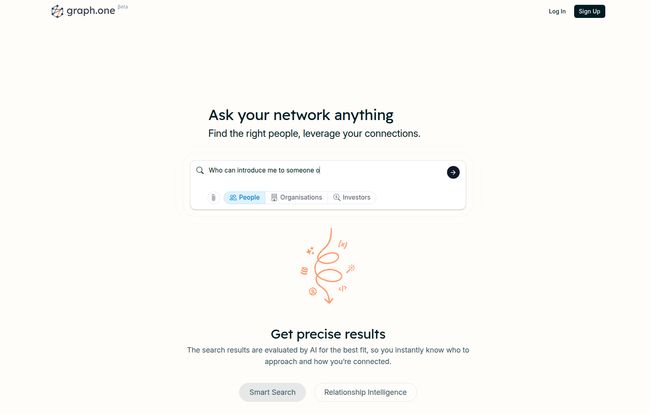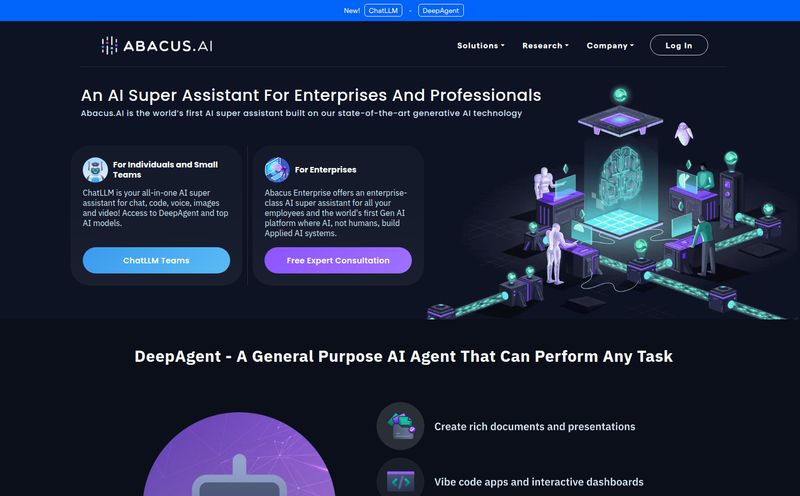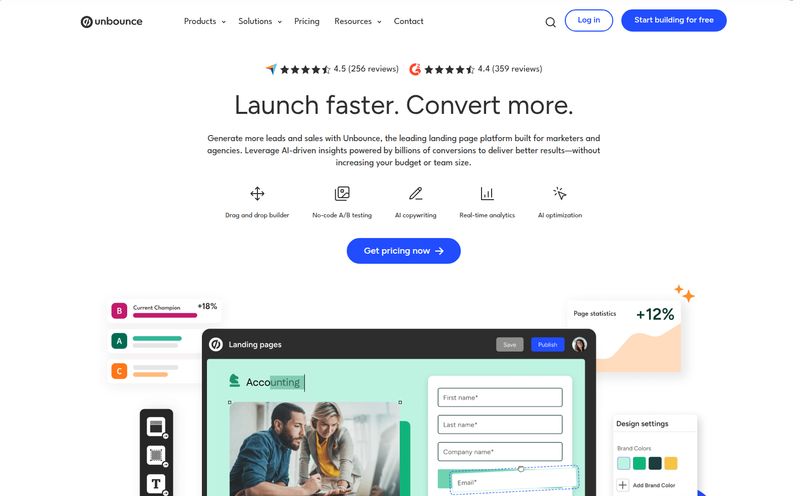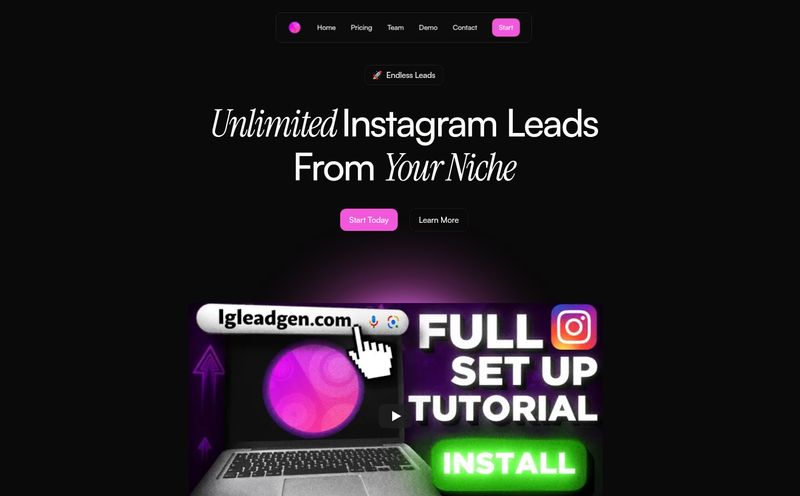We’ve all heard it a million times. The old, tired cliché that makes you want to roll your eyes so hard you see your own brain: “It’s not what you know, it’s who you know.”
Ugh. But the annoying thing is, it’s true. As someone who’s spent years swimming in the deep ends of SEO, traffic gen, and CPC campaigns, I can tell you that the best leads, the best jobs, the best everything often come from a connection. A warm introduction. A little nudge from someone who can vouch for you.
The problem? Our networks are a mess. They're scattered across old email accounts, forgotten calendar invites, and a LinkedIn profile that’s half-full of people you met once at a conference in 2017. Actually using this network feels like trying to assemble IKEA furniture in the dark. It’s a nightmare.
So, when I stumbled upon a tool called Graph.one, which claims to map your real professional network using AI, my curiosity was definitely piqued. Could this be it? The tool that finally makes sense of the chaotic web of people we know? I decided to plug in and find out.
So, What on Earth is Graph.one?
Let's get this out of the way first. Graph.one isn't another social network. Thank god. It’s not a place to post updates or collect endorsements. Think of it more like a personal intelligence agency for your career.
It connects to your email and calendar (like Google Workspace or Outlook) and analyzes the metadata. This is a super important point I'll come back to. It looks at who you email, who you meet with, and how often. It then uses this data to build a dynamic, searchable map of your professional relationships. It’s like it takes all those invisible threads of communication and makes them visible. Suddenly, you can ask a simple question like, “Who do I know at Google?” or “Who can introduce me to an investor in Berlin?” and get an actual, actionable answer.
It doesn't just show you a connection; it shows you the path to that connection, often through the person you have the strongest relationship with. It's the difference between knowing a name and knowing the way.
My First Look: Plugging Into The Matrix
The homepage is clean, minimal, and makes a bold promise: “Ask your network anything.” I’m a sucker for bold promises. The call to action is simple: “Activate Your Network,” with the reassuring text “No Credit Card Required.” As of writing, the tool has a little ‘beta’ tag next to its logo, which is key. It sets the expectation that this is a work in progress, which is fair enough.

Visit Graph.one
The setup process involves giving it permission to access your email and calendar data, which might give some people pause. But the platform is very clear about its privacy-focused approach. It’s not reading your emails. It couldn’t care less about what you and your coworker said about last night's game. It’s only looking at the 'to', 'from', and 'when' – the digital handshakes that build a network. After a short processing period, it presents you with your network, visualized and ready to be explored. It’s a pretty wild moment, seeing years of communication laid out as an intelligent, explorable map.
The Standout Features That Genuinely Impress
After playing around with it for a while, a few features really stood out as more than just gimmicks. They feel like they could genuinely change how people approach professional networking.
The AI-Powered Search is a Bit of a Mind Reader
The search bar isn't just a keyword finder. Graph.one calls it “Smart Search,” and it feels about right. You can type in natural questions, and the AI seems to grasp the intent behind them. For example, asking for “someone who understands financial services lawyers” is different from just searching for a lawyer. The AI seems to pick up on these subtleties, pulling connections based not just on job titles but on the context of your past interactions. It’s this “Relationship Intelligence” that moves it beyond a simple database.
Discovering the Path of Least Resistance
This is the secret sauce. The holy grail. Finding warm introduction paths. We’ve all done the LinkedIn dance: you find someone you want to talk to, see you have a 2nd-degree connection, and then have to awkwardly ask that mutual connection, “Hey… so… how well do you actually know this person?”
Graph.one aims to kill that awkward dance. Because it bases its analysis on communication frequency and meetings, it can tell you that while you’re connected to Bob, your relationship with Susan is way stronger, and Susan talks to the target person all the time. That's your path. It's about finding the most effective, least awkward route to a conversation. This is huge for anyone in sales, fundraising or business development.
A Serious Nod to Privacy
I have to bring this up again because in our data-paranoid world, it’s everything. Giving a tool access to your inbox feels scary. But Graph.one's commitment to only analyzing metadata is the correct approach. They don't need the content of your emails to know you have a strong working relationship with someone. The fact that you've exchanged 50 emails and had 10 meetings in the last six months tells the whole story. By focusing on these patterns, they sidestep the massive privacy nightmare of content analysis. For me, this was a prerequisite for even trying it out.
Who Should Be Using Graph.one Right Now?
While I think almost anyone could get some value out of this, a few groups will see an almost immediate ROI.
- Founders & Entrepreneurs: Stop cold-emailing VCs. Use this to find out which of your advisors, friends, or ex-colleagues has a real, active relationship with a partner at Andreessen Horowitz or your dream seed fund. It's a massive competitive advantage.
- Sales & Business Development Reps: This is your new best friend. Before you send that generic InMail, imagine being able to find the one person in your extended network who can give you a glowing intro to the decision-maker at a target account. It could literally change your quota attainment.
- Recruiters & Talent Scouts: Sourcing is all about referrals. This tool can uncover hidden gems in your company's collective network, showing you the most trusted paths to reach top-tier talent.
The Good, The Bad, and The Beta-Stage Realities
No tool is perfect, especially one still in beta. So let’s get real about the pros and the cons.
What I’m Genuinely Excited About
The core concept is brilliant. It’s a shift from quantity (how many connections you have) to quality (the actual strength of those connections). The focus on warm intros is a laser-sharp solution to a universal problem in the professional world. And the privacy-first model isn't just a feature; it's a foundation of trust. I also love the API-first design. It suggests a future where this intelligence can be plugged into other tools, like a CRM, which is incredibly powerful.
The Current Bumps in the Road
Okay, it’s not all sunshine and rainbows. The most glaring issue for me is the lack of mobile support. I do a lot of my networking and email on the go, and not having an app to quickly check a connection is a definite miss. I hope this is high on their to-do list.
Another thing to consider is that its power is directly proportional to your data. If your professional life is split across five different email addresses, or if you just started a new job, the map will be incomplete. It's a reflection of your digital history, so if that history is sparse, so is the tool's utility. This isn't really a flaw of the tool itself, more a law of physics you need to be aware of.
The Million-Dollar Question: What's the Price?
Here’s where things get interesting. As of my review, there is no public pricing. The main page invites you to activate your network with no credit card, and the images show a broken pricing page link. My guess? Given the 'beta' tag, they're likely running a free beta period to gather feedback and refine the product. This is common practice. It could eventually become a freemium model (e.g., a certain number of searches for free) or a tiered subscription. For now, it seems to be free to try, which makes it a complete no-brainer.
Frequently Asked Questions About Graph.one
1. How does Graph.one actually protect my privacy?
Graph.one is built on a privacy-first principle. It does not read the content, body, or attachments of your emails. It only analyzes the metadata—information like the sender, recipient, timestamp, and meeting attendees—to understand the strength and frequency of your professional relationships.
2. Is Graph.one just a replacement for LinkedIn?
Not at all. Think of it as a complementary intelligence tool. LinkedIn is a public-facing directory of self-reported information, which is great for discovery. Graph.one is a private, internal map of your actual interactions, designed to reveal the strongest, most actionable paths within your existing network.
3. Can I use Graph.one on my phone?
Currently, Graph.one does not have a dedicated mobile app. It's a desktop/web-based platform for now. This is one of the main limitations of the tool in its current beta phase.
4. What if I use multiple email accounts?
The platform allows you to bring your network data together from various sources, including different email accounts. The website mentions that its "identity resolution automatically merges contacts across all your sources." This helps create a more complete and accurate map of your entire network.
5. Is Graph.one free to use?
As of late 2024, Graph.one is in a beta phase and appears to be free to use, with no credit card required to sign up. They have not released official pricing plans yet, so this could change in the future.
The Final Verdict: Should You Let It Map Your Network?
So, is Graph.one the revolutionary tool it claims to be? I think it's damn close. It's one of the most interesting and genuinely useful takes on professional networking I've seen in years.
It’s not just another app to manage; it's a tool that provides genuine intelligence. It turns a passive archive of data (your inbox) into an active, strategic asset. The world runs on relationships, and this tool gives you a clear, honest, and powerful view of yours. The lack of a mobile app and its reliance on historical data are real considerations, but they don't overshadow the core value.
For any founder, salesperson, or ambitious profesional who understands that a warm intro is worth a thousand cold calls, giving Graph.one a try while it’s in free beta is a no-brainer. This is a tool I’ll be watching very, very closely. It just might be the map you need to find your next big opportunity.
Reference and Sources
- Graph.one Official Website
- Graph.one on Product Hunt (Based on the information provided)



